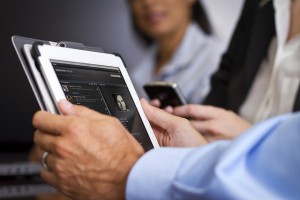How Using Tablets For Construction Vastly Streamlines the Process
 In today’s business environment, many different industries are starting to see the advantages of keeping employees connected to their work and each other with mobile devices. This is especially true in surveying. Allowing field crews to access documents and information from mobile devices allows them to be just as productive on site as they would be at an office. This means that projects can progress more quickly, without the need for long delays caused by employees being offline or needing to travel back and forth between a job site and an office.
In today’s business environment, many different industries are starting to see the advantages of keeping employees connected to their work and each other with mobile devices. This is especially true in surveying. Allowing field crews to access documents and information from mobile devices allows them to be just as productive on site as they would be at an office. This means that projects can progress more quickly, without the need for long delays caused by employees being offline or needing to travel back and forth between a job site and an office.
Traditional surveying handhelds do not offer the variety of applications that are needed in modern surveying. Professional land surveyors, especially those working on oil and gas projects, have a lot more data to collect and process while on site. They also need to be able to review this information, answer emails, and perform any number of other tasks on the fly, which is something that is simply not possible with traditional handhelds.
Fortunately, there is a solution: professional land surveyors can utilize “rugged tablets” for construction, which are designed specifically for use in high-intensity industry settings like an oil and gas job site. These tablets, like the Trimble Yuma 2, are built from the ground up to be tough, effective, and easy to use while on a job site.
These tablets are designed with the importance of accurate GPS data squarely in mind. For example, the Trimble Yuma 2 offers 1-2 meter real time Enhanced GPS positional accuracy, allowing users to get extremely detailed and accurate positions while on the job site.
The GPS abilities of these tablets are also very convenient and easy to use, as they are built right into the tablet itself. Users don’t need to attach an external antenna in order to get an accurate reading; they have everything they need to do that right in their hands. However, these tablets often provide the flexibility to add an external GPS antenna when needed to achieve maximum accuracy.
Greater Strength and Durability
While consumer tablets have made a lot of advancements over the years, the fact remains that these tablets are simply not designed with durability or ruggedness in mind. As far as the tablet manufacturers are concerned, the most stress that will ever be placed on one of these tablets is being dropped from a few feet.
On the other hand, tablets used on oil and gas sites constantly have to deal with dust, water, extreme temperatures, high altitudes, vibrations and shock. A consumer tablet can’t deal with these factors, even if you do slap a hard protective case on them. Surveyors need tablets for construction that are durable by design, and that’s exactly that a rugged tablet is.
A Touchscreen That’s Easy To Use and Read
Most consumer tablets are designed to be used indoors, under optimal conditions. Try using one on a job site, and you’ll have to deal with a glare off the screen that makes it hard to read.
Rugged tablets like the Trimble Yuma 2 offer a screen with an outdoor readable display, as well as the flexibility to control the touch screen using fingers, a stylus, or capacitive gloves. This means that surveyors on oil and gas job sites will always be able to read and control the screens on their tablets, no matter what the conditions.
To learn more about how Landpoint uses tablets for construction and how these devices can help bring unique benefits to your project, download our oil and gas brochure.
Image Source : NEC Corporation of America

